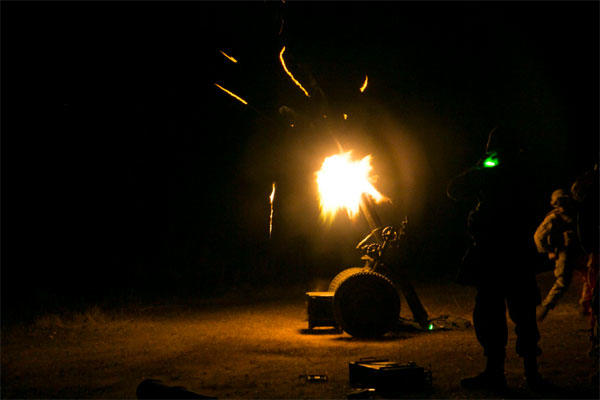The Marine Corps is in the early stages of a complex revamp of its artillery doctrine that will enable the force to be lighter, faster and more lethal in order to respond to future conflicts and a new style of fighting.
At the heart of this revamp is Expeditionary Force 21, the Corps' new concept of fighting that emphasizes smaller units functioning independently over distributed areas in Pacific littoral zones and other regions. Among the ideas the Corps is testing out is that of having artillery platoons provide direct support to Marine companies for ship-to-shore maneuvers and other expeditionary movements. Earlier this month, some 200 troops from 10th Marine Regiment out of Camp Lejeune, N.C. participated in an experiment that paired different weapons from their artillery arsenal with a company landing team to determine the feasibility of this approach in realistic fighting conditions.
It's a departure from the Marines' traditional approach, which has larger artillery batteries supporting entire battalions of Marines.
"Artillery support in support of ground forces, our infantry, it provides bigger bang for the buck, the ability to reach out and touch the bad guys with large caliber indirect weapons systems," Capt. Jay Dodge, artillery training school director for 10th Marine Regiment, told Military.com. Dodge said the idea of deploying gun platoons in support of smaller infantry elements was new territory for the Marines.
"This is not how we fight. It's a change to our doctrine," he said.
The eight-day experiment, which also involved personnel from Lejeune's 1st Battalion, 6th Marines, ran a company landing team through the same series of movements with a sequence of three artillery pieces: the M327 120mm mortar; the M777A2 155mm howitzer; and the Army's M119A3 105-mm cannon.
Col. Jeffrey Holt, experimentation division director for the Marine Corps Warfighting Lab, said the use of an Army weapon demonstrated the willingness of the units involved to venture beyond convention to develop the best solution for future warfighting.
"We're pushing hard on the envelope with 2nd Marine Division and specifically 10th Marine Regiment to find out what can be used," he said. "They had the courage to look past programs of record."
The teams conducted a movement to contact, set up fire support positions, and executed a breach through a dense urban environment, simulated by Lejeune's Military Operations in Urban Terrain facility.
"When you have tight confines, it's really challenging to maneuver some of these pieces on the battlefield," Holt explained.
Holt said the lab found each of the guns had different strengths for company landing team support. The 120mm mortar, which can be transported inside an MV-22 Osprey with its all-terrain transport vehicle, was attractive with its lightness and ease of set-up, he said. However, the system isn't capable of direct fire.
"If you're going to break a wall down, you need a direct-fire asset to do that," Holt said.
The 155mm howitzer offers a reliable weapons system, a heavier one that requires a helicopter to insert it and a 7-ton truck to pull it.
"You've got to figure out, ‘how do I move that,'" he said.
The 105mm gun presented an attractive alternative: a smaller, more maneuverable piece capable of direct fire that was very similar, mechanically, to the 155mm howitzer. Holt said the system was less accurate than the 155mm, but had improved with recent updates.
"It definitely has us thinking," he said.
The Warfighting Lab is still assessing data collected from the experiment to determine conclusions and next steps. But for Dodge, the effort provided some immediate insights. He said the biggest challenge was streamlining communication and and developing a protocol regarding who reported to whom in the chain of command. It also illuminated the importance of joint training between infantry and artillery elements, he said. During the wars Iraq and Afghanistan, he said, this kind of joint training had fallen by the wayside.
"One ancillary benefit that came from this is we're doing our part to meld that relationship again between infantry and artillery," Dodge said.
The Warfighting Lab is preparing a report for the commanders of the Marines' operating forces on the experiment, which will determine future steps to develop the concept. Meanwhile, Holt said, a range of other efforts to modernize the Corps' artillery elements are also underway.
The Marines recently announced that it would field GPS-guided rounds for the 120mm mortar system in 2018, allowing troops to reduce the number of rounds needed to destroy a target. The Marines are also working to develop a more complex role for its high-mobility artillery rocket system, or HI-MARS, including the development of advanced guided munitions that would be able to hit a moving target, or launch from a ship while it's underway. And as rockets become more accurate, Holt said, the Marine Corps is examining different uses for them, including the possibility of making certain rockets organic to a company-sized element.
Marines will have a chance to test out some of these concepts at the Rim of the Pacific joint exercise this summer in Hawaii, Holt said.
-- Hope Hodge Seck can be reached at hope.seck@monster.com. Follow her on Twitter at @HopeSeck.




























